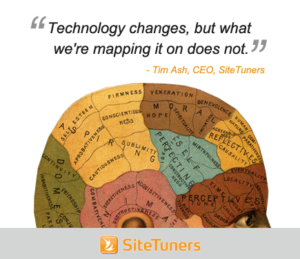 Think back to the year Netscape launched in 1995, and popularized the internet. Try and remember what surfing the web was like back then – recall how no two sites worked the same way, how elements that serve the same functions were in different places and looked nothing alike, and how there’s no usable search engine to make sense of it all. Now think back to 2002 – sure, plenty of web sites still did random things, but the web had done some growing up: standards had been developed, and things were more organized.
Think back to the year Netscape launched in 1995, and popularized the internet. Try and remember what surfing the web was like back then – recall how no two sites worked the same way, how elements that serve the same functions were in different places and looked nothing alike, and how there’s no usable search engine to make sense of it all. Now think back to 2002 – sure, plenty of web sites still did random things, but the web had done some growing up: standards had been developed, and things were more organized.
That was the web, 7 years after being accepted into our general consciousness.
We’re now 7 years into the mobile revolution. It’s crazy to think that the iPhone launched in 2007, but it did, and many of the same problems that plagued the web users in 1996 plagued mobile web users in 2008 – no standardization, things randomly breaking, you name it. And then we started seeing mobile versions of web sites, and Responsive Web Design, and even though some implementations of those items made things worse, there are starting to be enough people who looked at the data, and the user experience, and developed something useful even on mobile devices.
Seven years in, mobile is growing up as well. Not quickly enough, not at the pace we need it to, but it is growing up. And it looks like alongside core posts about conversion design, and analytics posts to make sense of user behavior, readers like you really care about how mobile should mature in terms of conversions and usability. Here are the 15 posts that you viewed this year:

One of the early Halloween posts tackled persuasion, scarcity in e-Commerce, and BJ Fogg’s behavioral model. If you know fear factors into the conversion process but unsure about how it’s applied properly to web sites, this post provides practical examples.
14. Mobile/ Analytics: Are Smartphones Bad at Conversions?
What are smartphone conversion rates like? What about tablets? What tools do you need to improve those conversions, and help people achieve what they need on various devices they use to access your site? This post looks at the current figures, and helps you dissect what’s working and what isn’t on the mobile front.
13. Usability/ CTAs: 4 Tips for Creating an Effective Call-to-Action
Calls-to-action are pretty critical components of web sites, and every now and again it pays to revisit if the ones we have on our site need a little help. This post tackles the levers you can tweak for your CTA prominence, and the science behind those levers.

Internally, everyone has an opinion about graphics. The C-suite want panache, designers want a canvass brimming with creativity, web developers want the graphics to be small enough that they don’t interfere with page load time. Meanwhile, your users just want to get their tasks done. This post tackles the disconnect between what web site owners and web users want, and what you can o to bridge that difference.
11. Conversion Design: Boost Conversions through Practical Design Changes
Buttons and layouts can seem like solved problems, but they are typically tested for on your top pages – that can leave the rest of your site less than optimal. Because it’s impractical to test all the areas of your site, you need to settle on a baseline – and this post shows examples of good design that actually helps your site convert.
10. Conversion Design: 8 Rapport Building Tactics to Increase Conversions
Web sites are efficient sales tools, but once you play in the digital realm, you lose a lot of your face-to-face rapport-building techniques. Thankfully, if you play your cards right, you can get some of it back – this post talks about which techniques you can successfully execute online, and how they help your site convert.

Mobile isn’t really eating into time spent using desktops and laptops so much as it is eating into time spent consuming all other media – TV, print, etc. So you can’t just tank your desktop experience in favor of smartphones and tablets – that’s just as disastrous as doing nothing about the emergence of mobile. This post helps you avoid the worst mistakes companies make while adapting to a multi-device world.
8. Usability: Can a Flat Design Lead to Increased Conversions?
With the rise of smartphones and tablets comes the popularization of flat design – that is, the removal of bevels, shadows, gradients, and other elements that help users perceive depth. Because flat design can help sites load more quickly, and because its simplicity can sometimes help users find what they need, a significant number of web sites are making the transition. However, flat design also opens the floodgates to significant usability issues – this post talks about the pros and cons of flat design, and what you can look at to see if it’s right for you.
7. Conversion Design: Increase Your Conversions with the Right Color
Colors may seem trivial, but they do have a significant impact on your site’s ability to convert visitors into customers. If you need help identifying which colors to use for the general site template versus your calls-to-action, this post is for you.

Technology may change rapidly, but our brains haven’t had an evolutionary leap in the past 50,000 years – and what that says about marketing tactics that continue to work is huge. This post covers the psychology behind tactics that work, and how you can apply them to your web site.
5. Personalization: 4 Advanced Techniques to Boost Form Fills
Sometimes, you need to know all the strategic things you are missing out on for your landing pages, other times, you just need the darned forms to convert better. This post is the latter – if you need a refresher on what makes forms work, this one’s for you.
4. Persuasion: 5 Ways to Use Your Visitors’ Cognitive Biases to Your Advantage
Conversions, when you strip away all the related and tangential fields, are about psychology. You’re selling to a brain that is predisposed to be motivated a certain way, and make decisions a certain way. This post talks about the cognitive biases that your visitors are likely to have, and practical changes that you can make to improve the experience based on neuroscience.
3. CTAs: How Pronouns Affect Conversion Rates
Here we go, top three.
And there are no surprises here – it makes total sense for this blog to have a most-viewed post that talks about the call-to-action. If you need to brush up on the language that gets people to convert, read on.
2. Mobile/ Analytics: 5 Deadly Mobile Conversion Mistakes and How to Avoid Them
This one, by contrast, is a pleasant surprise.
The second-most viewed entry this year talks about mobile conversions and analytics – it’s nice to validate that our conversion-savvy audience is paying attention to the changes to the online landscape. If you haven’t yet, go ahead and read on about what you can do with data to solve problems for your site’s mobile experience.
And the most viewed post for the year is …
1. Conversion Design: 7 Things You’re Doing Wrong on Your Landing Pages and How to Fix Them
Our core audience consistently validates that there’s value in refining the landing page year after year. This is, after all, a blog tied to Landing Page Optimization – literally the book that popularized the idea of targeted refinements to landing pages. The year’s most viewed post talks about practical changes to landing pages that help site owners avoid the worst errors – go ahead and review it if you have time to spare, and for those who have read it, we hope it was of use.
Happy holidays, everyone!

